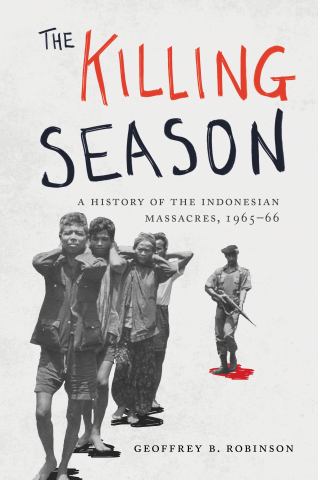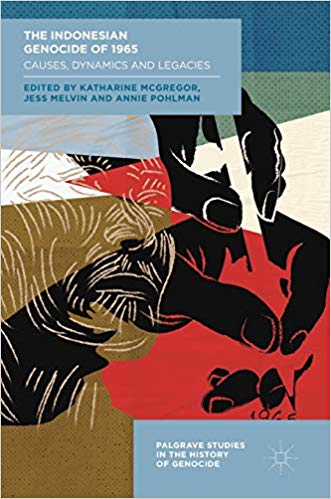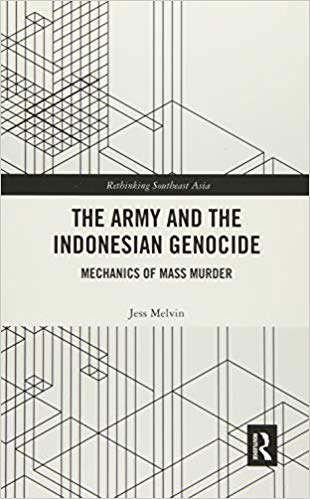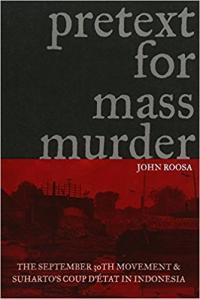|
 |
|
Special issue of Tempo magazine
timed for release of The
Act of Killing. |
These axes jockeyed for power,
especially as Sukarno created and
dissolved cabinets with regularity
in the 1950s until the 1959 implementation
of “Guided Democracy,” Sukarno’s
plan for stability that forewent
elections. The military (and its
U.S. backers) and political Islamists
grew concerned over the PKI’s popularity,
and the military became increasingly
belligerent. The PKI, led by firebrand
Aidit, reacted by demanding greater
political power and creating para-military
organizations. The nationalist campaigns
to seize West Papua and confront
Malaysia in the early 1960s were
used to distract Indonesians from
their domestic political and economic
concerns.
 |
|
|
Maj. Gen. Suharto, left
front, with Gen. Sabur,
commander of the presidential
guard, October 1965.
|
|
In this context
of political and economic chaos,
members of Sukarno’s Presidential
Guard kidnapped six generals and
a lieutenant on the morning of October
1, 1965. The officers were murdered,
and the kidnappers - calling themselves
the 30th of September Movement -
said they were acting to prevent
an anti-Sukarno coup d’état. A quick
response and counterattack was organized
in Jakarta, led by Major General
Suharto, then the leader of the
military’s Jakarta-based Strategic
Reserve (Kostrad) troops. Within
a day of the coup, Suharto had gained
control of the military and the
PKI was blamed for the kidnappings
and murder, although evidence casts
doubt as to how well-coordinated
the plot was. Observers have also
raised questions about what Suharto
might have known prior October 1,
since he was not targeted and appeared
poised to take quick advantage of
the situation. An above-ground,
legal, popular, and mass-based political
party was criminalized overnight,
with membership punishable by death.
PKI members,
their families, and their associates,
but also other leftists, critics of
the military, ethnic Chinese, and many
others, were rounded up and murdered
or told to report to the government.
Many did so willingly, completely unaware
of the fate that would befall them –
they had done nothing criminal, after
all, and didn’t fear for their safety.
| |
I urge us all to examine ourselves,
and acknowledge that we
are all closer to perpetrators
than we like to believe.
The United Kingdom and United
States helped to engineer
the genocide, and for decades
enthusiastically supported
the military dictatorship
that came to power through
the genocide. We will not
have an ethical or constructive
relationship with Indonesia
(or so many other countries
across the global south)
going forward, until we
acknowledge the crimes of
the past, and our collective
role in supporting, participating
in, and, ultimately, ignoring
those crimes."
-
speech
by Joshua Oppenheimer
accepting BAFTA award
for best documentary
|
The
military, police, and Muslim groups
formed citizen militias to do the
dirty work. In Medan, for example,
as shown in the of
Act of Killing,
local gangsters were recruited to
do the killing. Throughout Sumatra,
Java, and Bali, and to a lesser
extent elsewhere, a bloodbath began.
Rivers were choked with bodies and
flowed red with blood. Canyons became
the sites for group beheadings and
decapitations - one site is
known as the "Ravine of
Tears." The “luckier” ones,
frequently those whose guilt was
in question, were imprisoned and
tortured without trial. Within two
years, hundreds of thousands were
dead. Within six months, some 1.7
million
people were imprisoned. Suharto
assumed the presidency, the PKI
was liquidated, and political Islam
was shunted aside, as the military
took firm control of Indonesia.
Dissent was suppressed in the name
of fighting communism; many others
were too afraid to speak out. Elections
were managed to make sure only Suharto-backed
candidates won. The military dictatorship
would last until Suharto’s resignation
in 1998.
Former
political prisoners and their families
remained marginalized for decades; their
association noted on their ID cards,
employment opportunities closed off
to them. Although a few victims’ groups
have emerged since the start of Indonesia’s
democratic transition, they also remain
marginalized and threatened. Their meetings
are attacked and their members accused
of engaging in communist activity. Indonesia’s
official National Commission on Human
rights (Komnas HAM) recently investigated
the killings and
published a report. Although its
scope and budget were limited, it found
horrendous abuses associated with the
anti-communist purge. The commission
recommended either non-judicial action
to restore a sense of justice for the
victims or that the Attorney General
proceed with cases. The Attorney General,
Darmono,
said he could not act because "The
1965 rights violations are beyond (the
scope of) the existing law." No
action has yet been taken on the report.

U.S.’s dark history
in the Indonesia’s mass violence
Although the
political struggle and the resultant
mass violence were the culmination of
decades of conflict among Indonesians,
the U.S. sanctioned, encouraged, and
assisted the killings. The U.S. government
was concerned that Indonesia might fall
to communism as events in Vietnam, Cambodia
and Laos (as well as Latin America)
were heating up.
 |
|
|
Presidents Kennedy and Sukarno,
Andrews Air Force Base,
Suitland, Maryland, April
1961. Photo JFK Library
and Museum. |
|
The U.S. role
in early Indonesian politics dates
back to the revolution, when it
assisted in negotiations on independence
between the Dutch and Indonesian
nationalists. Less than a decade
later, the US was sending arms and
support to rebels in Sulawesi and
Sumatra who were fighting the central
government in an effort to topple
Sukarno.
The assistance included
sending U.S. bombers from their base
in the Philippines to attack targets
in Indonesia. This ended after U.S.
pilot Allen Pope was captured on May
18, 1958. His plane was shot down after
bombing a church in Ambon. Without U.S.
support, the rebellion was quickly crushed.
Despite the U.S. role in the rebellion,
anti-Sukarno military officers continued
to discuss with the U.S. their mutual
goal of toppling Sukarno and undermining
the PKI.
The Kennedy administration
facilitated the turnover of resource-rich
Western New Guinea (West Papua) by The
Netherlands, first to the UN and then
Indonesia, against the wishes of its
inhabitants. This was done to endear
itself to Sukarno and the Indonesian
military and
perhaps for economic reasons.
The U.S. stepped
up military aid and its training of
Indonesian officers and police. In the
early sixties, U.S. security assistance
focused on “civic action: as a nation-building
exercise, as a counterinsurgency strategy,
and, not incidentally, as a front for
covert operations aimed at the PKI.”[i]
Prior to the events of October 1,
Indonesian military officers speculated
that a failed coup attempt by the
PKI would provide a perfect pretext
for eradicating the party, and this
idea was shared with the US embassy
staff, who encouraged it and pledged
support. In January 1965, the U.S.
ambassador reported to Washington
that the Indonesian army was “developing
specific plans for takeover of the
government moment that Sukarno steps
offstage.” The cable continued that
some top military commanders were
prepared before Sukarno’s death
should the PKI form an armed civilian
militia. They would act in a way
that appeared to leave Sukarno in
charge.
[ii]
| |
The
New York Times’ James Reston
called the “savage transformation…
a gleam of light in Asia.”
Richard Nixon wrote "containing
the region's richest hoard
of natural resources, Indonesia
constitutes by far the greatest
prize in the Southeast Asian
area."
|
As events unfolded
in the days following October 1, American
diplomatic and intelligence staff encouraged
the eradication of the PKI, and closely
monitored the Indonesian military’s
actions. Robert Martens, head of the
US embassy’s political affairs bureau,
gave the army thousands of names
of suspected PKI members. U.S. officials "checked
off the names of those who had been
killed or captured.” The embassy also
transferred cash to leaders of the anti-PKI
movement. As soon as Suharto’s command
was consolidated, the US and other Western
countries pledged millions of dollars
in economic assistance, and Suharto
reversed Sukarno’s policy by opening
the country up to foreign investment.[iii]
The New York Times,
quickly praised the coup. In a page
one story on October 11, reporter
Max Frankel wrote that there was
“hope where only two weeks ago there
was despair about the fifth most
populous nation on earth, whose
103 million inhabitants on 4,000
islands possess vast but untapped
resources and occupy one of the
most strategic positions in Southeast
Asia.”[iv]
In June 1966, the Times’ James Reston
called the “savage transformation… a
gleam of light in Asia.” Time magazine
hailed Suharto’s takeover as “the West’s
best news for years in Asia.”[v]
Later,
Time Inc. sponsored a closed-door "Indonesian
Investment Conference" in Geneva
in November, 1967, the first such conference
since Suharto seized power.
In 1967, Richard
Nixon argued that "The U.S.
presence... was a vital factor in the
turnaround in Indonesia, where a tendency
toward fatalism is a national characteristic.
It provided a shield behind which the
anti-communist forces found the courage
and the capacity to stage their counter-coup
and, at the final moment, to rescue
their country from the Chinese orbit.
And, with its 100 million people, and
its 3,000-mile arc of islands containing
the region's richest hoard of natural
resources, Indonesia constitutes by
far the greatest prize in the Southeast
Asian area."
By the end of 1968,
the CIA was downplaying Suharto’s
brutality, writing in a classified National
Intelligence Estimate that “the Suharto
government provides Indonesia with a
relatively moderate leadership.” Adding
that “There is no force in Indonesia
today that can effectively challenge
the army's position, notwithstanding
the fact that the Suharto government
uses a fairly light hand in wielding
the instruments of power.”
Later analyses of the violence showed
its often chaotic nature, despite
being organized from the top. Hermawan
Sulistyo’s PhD thesis
[vi],
for example, shows that the anti-communist
bloodletting was used by various
groups to eliminate their enemies:
landlords, tenants, ethnic Chinese,
debtors, etc. All one had to do
was accuse someone of being a member
of the PKI or a sympathizer, and
extrajudicial death was the result.
Those who were not killed on the
spot, frequently because the “evidence”
of their ties to the PKI was egregiously
spurious, were sent to prisons or
exiled to islands that became prison
camps, such as Buru. This was the
fate of Pramoedya Ananta Toer, Indonesia’s
best known author, who detailed
his experience in his memoir and
suffered persecution until the end
of the Suharto regime.
After-effects
Suharto
had consolidated his rule by early 1966,
and Sukarno had been shunted aside.
The tight bonds forged by the CIA and
diplomatic staff in Indonesia remained
during Suharto’s tenure (1965-1999).
U.S.-based multinational corporations
were free to plunder the country – it
is said that the first MNC to engage
with the Suharto government, Freeport
McMoRan, wrote its own contract with
immensely favorable terms – making sure
Suharto received his cut.
Time Magazine wrote in 1999 that
it “found indications that at least
$73 billion passed through the [Suharto]
family's hands between 1966
and last year." The New York
Times
reported that in 1989 the CIA
estimated Suharto's wealth at $30
billion. Freeport is Indonesia’s
largest foreign taxpayer. National
Security Adviser Henry Kissinger
told President Richard Nixon
in 1968 that the manner in which
Indonesia was to seize the territory
– in a
sham plebiscite that remains
widely condemned – was to be off
limits in discussion, essentially
giving Suharto a free hand. (Between
1988 and 1995,
Kissinger was paid $500,000
per year to be on the board of Freeport
McMoRan. And the American military
ramped up its engagement, free from
the constraints imposed under Sukarno.
In early 1976, soon after Indonesia
brutally invaded East Timor, a
State Department official said, "the
United States wants to keep its
relations with Indonesia close and
friendly. It is a nation we do a
lot of business with." Nearly
two decades later, a White House
official
called Suharto “
our
kind of guy” after the dictator
met with President Clinton. Suharto,
The New York Times wrote “
has
been savvy in keeping Washington
happy.”
The list of egregious
human rights violations during
Suharto’s New Order is lengthy,
including the “mysterious shootings”
incidents of the early 1980s, the 1984
Tanjung Priok massacre, and the persecution
and killings in West Papua and Aceh.
Among the most egregious was the 1975
invasion of former Portuguese colony
and newly declared independent state
Timor-Leste (East Timor), where up to
one-third of the population died in
the years following the invasion. Throughout
all of these human rights disasters,
the United States remained firmly on
Suharto’s side, pledging financial and
political support, encouraging investment,
and perhaps most troubling, providing
military aid and training, at times
contrary to the US Congress’ wishes
and in violation of US law. At
a State Department meeting on Timor-Leste,
one official told
Secretary
of State Kissinger how “happy [Indonesia
is] with the positions we have taken.
We’ve resumed, you know, all of our
normal relations with them…”
Kissinger responds: "Illegally
and beautifully,” a reference to the
fact that he had ignored the requirement
to suspend military assistance to Indonesia
for using U.S. weapons to invade its
neighbor. Daniel Patrick Moynihan, former
U.S. Ambassador to the United Nations,
bragged in his memoir of his ability
to stymie effective UN action on the
invasion of Timor-Leste.
The U.S. government would occasionally
condemn some of Indonesia’s human rights
violations, but its actions spoke louder:
during the 32-years of the Suharto dictatorship
the U.S. provided more than a billion
dollars' worth of weapons and other
military equipment. The Pentagon also
provided
training
highly valued by the Indonesian
military . Many of Indonesia’s most
notorious generals were trained in the
U.S. Only in the 1990s,
facing
congressional action and grassroots
pressure, did the administrations
start to restrict access to U.S. training
and weapons. The U.S. has never
apologized for its support of mass murder
and dictatorship in the aftermath of
the 1965 events, nor has it expressed
any regret for its support of Suharto’s
brutal military dictatorship that followed.
 |
|
|
Adi Rukun from The Look of
Silence. |
|
Indonesian relatives of those “tainted”
with ties to the PKI – however spurious
they may be – remain victims of abuse
in Indonesia and portrayed as enemies
of the state.
The experience of
Adi Rukun, the protagonist of
The Look of Silence, is
the
latest example. Out of concern for their
safety, he has chosen voluntary exile
and his family has moved elsewhere in
Indonesia, thousands of miles from their
home. The Indonesian crewmembers
of both films have chosen to remain
anonymous for their own security. Victims
of Suharto’s genocidal policies in
Timor-Leste and
West Papua – as well as victims
of other abuses – have yet to see justice.
As you watch the films Act of Killing
and The Look of Silence, ETAN
asks you to think of the victims and
to reflect on the role of the U.S. in
perpetrating and perpetuating these
crimes against humanity. The
ability of the perpetrators to make
their version of the story the official
one allows them to enjoy impunity for
their actions, an impunity that UK-based
human rights group TAPOL calls an obstacle
to Indonesia’s ongoing democratization.
And a thorough accounting of events
would also hold responsible figures
in the United States and other Western
countries who encouraged and supported
the violence.
As Indonesia and Timor-Leste specialist
Brad Simpson pointed out in a recent
article in
The
Nation, the U.S. role in the violence
portrayed in the films makes it our
“act of killing, too.
Take Action
ETAN is urging the U.S. government
to take two immediate steps: 1) Declassify
and release all documents related to
the U.S. role in the mass violence,
including
the CIA’s so-called “job files.” These
describe its covert operations. 2) The
U.S. should formally acknowledge its
role in facilitating the 1965-66 violence
and its subsequent support for the brutalities
of the Suharto regime. See
more action ideas here.
|
Order
from Amazon,
Support ETAN |
 |
 |
 |
 |
 |
The
East Timor and Indonesia
Action Network
(ETAN)
was founded in 1991. ETAN
s a U.S. based grassroots organization
working in solidarity with the peoples
of Timor-Leste, West Papua and Indonesia.
ETAN educates, organizes, and advocates
for
democracy, human
rights and justice. Website:
www.etan.org. Twitter:
@etan009.
[i] Simpson,
Brad, Economists with Guns:
Authoritarian Development and
U.S.-Indonesian Relations, 1960-1968,(Stanford:
Stanford University Press, 2008)
p. 75
[ii] Roosa,
John, Pretext for Mass Murder,
(Madison: Wisconsin University
Press, 2006) p. 189
[iv] Quoted
in Roosa p. 16
[vi] “The
forgotten years: the missing
history of Indonesia's mass
slaughter, Jombang-Kediri, 1965-1966,”
(ASU, 1997)xxxx
Action
ALERT:
See/Show The Look of Silence and
Take Action on U.S. Support for Mass
Violence in Indonesia
See also
